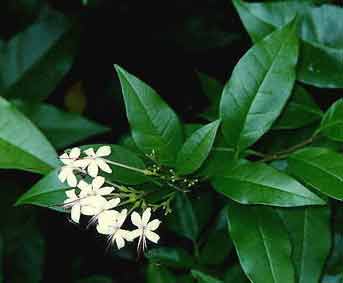
Uses: The wood of this plant is used to make fishing poles and fish traps (with kōñe and kūtaak), and the flowers of Wūlej are used in flower garlands. As part of a reconciliation, one may wreathe the head of an offended person with a wūlej garland. Thus there is the following:
Marshallese saying: "Wūlej in kaennōmman," ("Wūlej brings peace"). One might also give a wūlej lei to a person suffering from depression. Wūlej is a fragrant and attractive flower used to perfume coconut oil, and its pleasant scent may symbolize good social relations and a peaceful state of mind. Wūlej growing in Kuwajleen yards, however, has no odor. Some say that fragrant Wūlej grows in the swampy interior, pat, of islands. Parts of the plant are also used in medicinal preparations. For example, Wūlej is an ingredient in a baby bath preparation intended to prevent body odor in later life. |
Description: This indigenous, sprawling or climbing shrub grows to heights of 2-8 m (6-28 ft) and has attractive whitish flowers 3.5-5.5 cm (1.5-2 in) long with purplish stamens (the male reproductive organs of the plant that produce pollen) extending beyond the petals. The oval-shaped fruit, about 1-1.5 cm (0.5 in) long, splits into four, single-seeded small nuts (nutlets) when mature.
Distribution: Wūlej is found in the coastal vegetation from tropical Asia to Western Polynesia, and in all the major island groups of Micronesia. On high islands, it grows at the landward edge of the mangroves, in some swampy areas, along lowland streams, and sometimes in secondary vegetation, as well as in rocky and sandy near shore areas.

|

